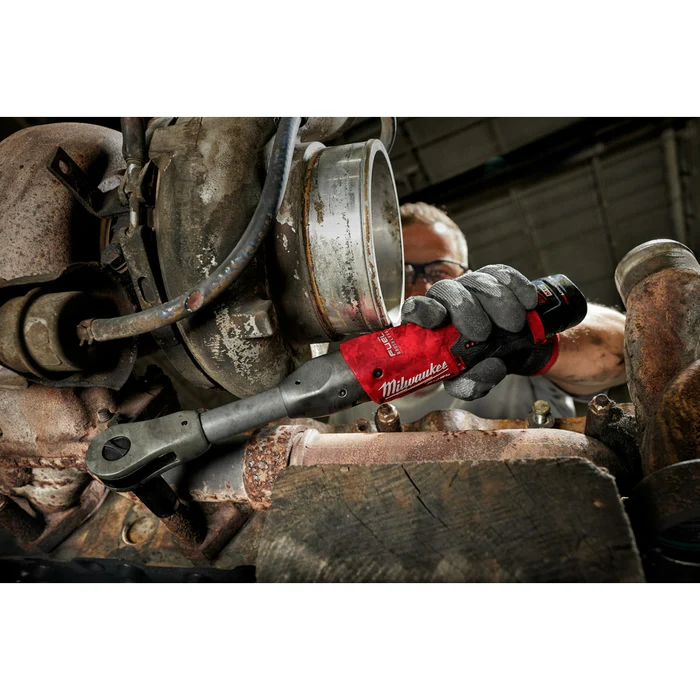An electric ratchet is a power tool designed to provide rotational force for tightening or loosening nuts, bolts, and other threaded fasteners. Unlike traditional manual ratchets, electric ratchets are powered by a rechargeable battery or an electric motor, allowing for greater torque and faster operation.
Electric ratchets typically consist of a housing that contains an electric motor, a gearbox, and a ratchet mechanism. The ratchet mechanism works in a similar way to a manual ratchet, allowing the socket or drive attachment to rotate in one direction while preventing it from turning in the opposite direction.
There are two main types of electric ratchets:
- Cordless Electric Ratchets: These ratchets are powered by rechargeable batteries, making them highly portable and convenient for use in various locations. They are commonly used in automotive repair, construction, and other industries where mobility is essential.
- Corded Electric Ratchets: These ratchets are powered by an electric motor and require a power source, such as a wall outlet or a generator. They are typically more powerful than their cordless counterparts and are often used in industrial settings or for heavy-duty applications.
Electric ratchets can come equipped with various features, such as adjustable torque settings, variable speed controls, and LED work lights for improved visibility in low-light conditions. They may also have ergonomic handles and compact designs for comfortable and efficient use in tight spaces.
Table of Contents
How Does an Electric Ratchet Work?
An electric ratchet is a power tool that combines the principles of a traditional ratchet wrench with an electric motor to provide increased torque and faster operation. The primary components of an electric ratchet are the motor, gearbox, ratchet mechanism, and power source.
Mechanism
The ratchet mechanism is the heart of an electric ratchet. It consists of a pawl and a gear with teeth oriented in a specific direction. The pawl engages with the gear teeth, allowing rotation in one direction while preventing reverse rotation. This ratcheting action enables the tool to tighten or loosen nuts and bolts with a reciprocating motion, eliminating the need to disengage and reposition the tool for each turn.
Power Source
Electric ratchets are typically powered by rechargeable batteries, such as lithium-ion or nickel-cadmium batteries. These batteries provide the necessary energy to drive the motor, which in turn powers the ratchet mechanism. Some models may also be corded and powered directly from an electrical outlet, offering continuous operation without the need for battery changes.
Ratcheting Action
The ratcheting action is achieved through the interaction between the pawl and the gear teeth. When the motor rotates in the desired direction, the pawl engages with the gear teeth, allowing the ratchet head to turn. When the motor reverses direction, the pawl slides over the gear teeth, enabling the ratchet head to remain stationary or move in the opposite direction, depending on the tool’s design.
This ratcheting action allows the user to apply continuous torque without having to remove the tool from the nut or bolt after each turn. The electric motor provides the necessary power to overcome resistance, making it easier to loosen or tighten fasteners, especially in tight spaces or when dealing with stubborn or rusted components.
Advantages of Electric Ratchets
Electric ratchets offer several advantages over traditional manual ratchets, making them a preferred choice for various applications:
Increased Speed and Efficiency: One of the primary advantages of electric ratchets is their ability to work at a much faster pace compared to manual ratchets. With the power of an electric motor, these tools can quickly tighten or loosen fasteners, significantly reducing the time required for tasks and increasing overall productivity.
Reduced Fatigue: Manual ratcheting can be a physically demanding task, especially when working with high torque requirements or in confined spaces. Electric ratchets alleviate this strain by doing most of the work for you, reducing the risk of fatigue, muscle strain, and potential injuries associated with repetitive motion.
Versatility: Electric ratchets are highly versatile tools that can be used in a wide range of applications, from automotive repairs to industrial maintenance. They are available in various sizes, torque capacities, and configurations, allowing users to choose the most suitable tool for their specific needs.
Portability: Many electric ratchets are designed to be compact and lightweight, making them easy to carry and maneuver in tight spaces. Additionally, some models are cordless and battery-powered, further enhancing their portability and allowing for use in areas where access to power sources is limited.
Types of Electric Ratchets
Electric ratchets are available in a variety of types to suit different applications and user preferences. The primary categories include cordless and corded models, with each offering unique advantages.
Cordless Electric Ratchets
Cordless electric ratchets are powered by rechargeable batteries, providing increased mobility and convenience for users. These ratchets are ideal for working in tight spaces or areas with limited access to power outlets. They are particularly useful in automotive repair, construction, and maintenance tasks where portability is essential. Cordless ratchets typically offer lower torque output compared to corded models but provide sufficient power for most applications.
Corded Electric Ratchets
Corded electric ratchets are tethered to a power source, ensuring a continuous supply of electricity. These ratchets are known for their high torque output, making them suitable for heavy-duty applications such as industrial assembly, machinery repair, and construction work. Corded ratchets are often more powerful and durable than their cordless counterparts, but their mobility is limited by the length of the power cord.
Drive Sizes
Electric ratchets are available in various drive sizes, typically ranging from 1/4 inch to 1 inch. The drive size refers to the square or hexagonal opening that accepts sockets or attachments. Smaller drive sizes, such as 1/4 inch and 3/8 inch, are commonly used for automotive and household tasks, while larger sizes like 1/2 inch and 3/4 inch are better suited for industrial and heavy-duty applications.
Specialized Electric Ratchets
In addition to general-purpose electric ratchets, there are specialized models designed for specific tasks or industries. For example, some electric ratchets are designed for use in confined spaces, featuring slim or articulating heads for improved access. Others are built for high-torque applications, such as loosening or tightening large bolts or nuts. Specialized ratchets may also incorporate features like variable speed control, reversible operation, or integrated LED lighting for better visibility in low-light conditions.
Applications of Electric Ratchets
Electric ratchets are versatile tools that find applications in various industries, including automotive repair, construction, manufacturing, and maintenance. Here are some common applications:
Automotive Repair
Electric ratchets are indispensable tools in automotive repair shops and garages. They are commonly used for tightening and loosening bolts, nuts, and other fasteners during routine maintenance tasks, such as changing tires, brake jobs, and engine repairs. Their compact size and powerful torque make them ideal for working in tight spaces and tackling stubborn fasteners.
Construction
In the construction industry, electric ratchets are utilized for assembling and disassembling various components, including structural steel, scaffolding, and framing. Their ability to deliver high torque and speed makes them efficient for tightening and loosening large bolts and fasteners encountered in construction projects.
Manufacturing
Electric ratchets play a crucial role in manufacturing facilities, where they are used for assembling and maintaining machinery, equipment, and other industrial components. They are particularly useful in applications that require precise torque control and repetitive tightening or loosening of fasteners.
Maintenance
Electric ratchets are essential tools for maintenance professionals working in various industries, such as facilities management, HVAC, plumbing, and electrical. They are used for tasks like servicing equipment, repairing machinery, and performing routine maintenance on buildings and infrastructure.
With their versatility and power, electric ratchets have become indispensable tools across a wide range of applications, streamlining tasks and improving efficiency in various industries.
Choosing the Right Electric Ratchet
Selecting the appropriate electric ratchet for your needs is crucial to ensure efficient and safe operation. Here are some key factors to consider when choosing the right electric ratchet:
Torque Requirements: Evaluate the torque requirements for your specific applications. Electric ratchets are available in various torque ranges, typically from 10 to 800 ft-lbs. Ensure that the ratchet you choose has sufficient torque capacity to handle the fastening or loosening tasks you’ll be performing.
Battery Life: Electric ratchets are powered by rechargeable batteries, and battery life is an essential consideration. Look for ratchets with long-lasting batteries or those that offer quick charging times. This will minimize downtime and increase productivity, especially for prolonged or intensive use.
Ergonomics: Comfort and ease of use are crucial when working with electric ratchets, as they can help reduce fatigue and strain. Consider the weight, grip design, and overall balance of the ratchet. Ergonomically designed ratchets with rubber-coated handles or adjustable heads can provide a more comfortable and secure grip, reducing the risk of slippage or injury.
Price Considerations: Electric ratchets are available at various price points, ranging from budget-friendly options to premium, professional-grade models. Determine your budget and prioritize the features that are most important for your needs. While more expensive ratchets may offer advanced features and durability, budget-friendly options can still provide reliable performance for occasional or light-duty tasks.
When choosing the right electric ratchet, it’s essential to strike a balance between torque requirements, battery life, ergonomics, and price. Consider your specific applications, work environment, and personal preferences to make an informed decision that meets your needs and ensures safe and efficient operation.
Safety Precautions for Electric Ratchets
Electric ratchets are powerful tools that require proper handling and safety precautions to prevent injuries and accidents. Here are some essential safety guidelines to follow when using an electric ratchet:
Proper Handling: Always hold the electric ratchet firmly with both hands to maintain control and avoid sudden movements or slips. Keep your body positioned in a stable and balanced stance to prevent falls or strain. Never carry the tool by the cord or yank the cord to disconnect it from the power source.
Eye Protection: Wear safety glasses or goggles to protect your eyes from flying debris, sparks, or other particles that may be generated during operation. Electric ratchets can generate high torque, increasing the risk of projectiles or kickback.
Avoiding Pinch Points: Keep your hands and fingers away from pinch points, such as the ratchet head, sockets, and moving parts. These areas can easily trap or crush your fingers, leading to severe injuries. Always disconnect the tool from the power source before making any adjustments or changing sockets.
Battery Safety: If using a cordless electric ratchet, follow the manufacturer’s instructions for proper battery handling, charging, and storage. Do not expose batteries to extreme temperatures, moisture, or fire. Replace damaged or worn-out batteries immediately to prevent leakage or potential explosions.
By following these safety precautions, you can minimize the risks associated with electric ratchet use and ensure a safe and efficient work environment.
Maintenance and Care of Electric Ratchets
Proper maintenance and care are essential for ensuring the longevity and optimal performance of your electric ratchet. Here are some important tips to keep in mind:
Cleaning
Regularly cleaning your electric ratchet is crucial to prevent buildup of dirt, debris, and grease, which can affect its functionality and lifespan. Before cleaning, make sure to disconnect the battery or power source. Use a soft-bristle brush or a clean cloth to remove any visible dirt or grime from the exterior surfaces. Avoid using harsh chemicals or solvents, as they can damage the tool’s components.
Lubrication
Lubrication is essential for smooth operation and to reduce wear and tear on the internal mechanisms of your electric ratchet. Consult the manufacturer’s instructions for the recommended lubricant type and application frequency. Typically, a few drops of high-quality machine oil or grease should be applied to the moving parts and pivot points periodically.
Battery Maintenance
If your electric ratchet is cordless, proper battery maintenance is crucial. Follow the manufacturer’s guidelines for charging, storage, and replacement of the battery. Avoid leaving the battery fully discharged for extended periods, as this can damage its cells. Additionally, store the battery in a cool, dry place when not in use.
Troubleshooting Common Issues
Electric ratchets, like any other power tool, can experience issues from time to time. Here are some common problems and their potential solutions:
- Tool not turning on: Check the battery charge level, ensure the connections are secure, and inspect the power switch for any damage.
- Decreased power or torque: This could be due to a low battery charge, worn brushes (if applicable), or a need for lubrication.
- Unusual noise or vibration: Inspect the tool for loose components, worn bearings, or debris in the mechanism.
- Overheating: Prolonged use or excessive load can cause overheating. Allow the tool to cool down and check for any obstructions or binding.
If the issue persists or you encounter any other problems, consult the manufacturer’s troubleshooting guide or seek professional assistance.
By following these maintenance and care guidelines, you can extend the lifespan of your electric ratchet and ensure it operates at peak performance for all your projects.
Top Electric Ratchet Brands and Models
When it comes to electric ratchets, there are several reputable brands that stand out in the market. Each brand offers a range of models with varying features, torque capacities, and price points to cater to different user needs. Here’s an overview of some popular electric ratchet brands and their models:
DeWalt
DeWalt is a well-known brand in the power tool industry, and their electric ratchets are no exception. The DeWalt DCF680N2 20V MAX Lithium-Ion Cordless 3/8″ Ratchet is a popular model that delivers up to 35 ft-lbs of torque and a variable speed trigger for precise control. It features a compact and lightweight design, making it ideal for working in tight spaces.
Milwaukee
Milwaukee is another leading brand in the power tool market, known for its durable and high-performance tools. The Milwaukee 2457-20 M12 Fuel Ratchet is a standout model, offering up to 35 ft-lbs of torque and a compact design. It also features a brushless motor for increased efficiency and longer runtime.
Ingersoll Rand
Ingersoll Rand is a renowned name in the industrial and automotive sectors, and their electric ratchets are designed for heavy-duty applications. The Ingersoll Rand R3130 1/2″ Drive Cordless Ratchet delivers up to 60 ft-lbs of torque and a variable speed trigger, making it suitable for various applications, including automotive repair and maintenance.
Makita
Makita is a trusted brand in the power tool industry, known for its innovative and reliable products. The Makita XRW01Z 18V LXT Lithium-Ion Brushless Cordless Ratchet is a popular model that offers up to 35 ft-lbs of torque and a compact design. It features a brushless motor for increased efficiency and longer runtime, as well as a built-in LED light for improved visibility in low-light conditions.
AIRCAT
AIRCAT is a leading manufacturer of pneumatic and electric ratchets, catering to the automotive and industrial sectors. The AIRCAT 1355-XL 3/8″ Composite Ratchet is a popular model that delivers up to 55 ft-lbs of torque and features a durable composite housing for added durability.
When choosing an electric ratchet, consider factors such as torque capacity, speed settings, ergonomics, battery life, and overall build quality. Each brand offers models with unique features and specifications, so it’s essential to evaluate your specific needs and choose the one that best suits your application.
Future Trends in Electric Ratchet Technology
The future of electric ratchets looks promising, with advancements in battery technology, ergonomic design, and new features that promise to enhance their performance, efficiency, and user experience.
Advancements in Battery Technology
One of the most significant trends in electric ratchet technology is the development of more powerful and longer-lasting batteries. Lithium-ion batteries are becoming increasingly popular due to their high energy density, low self-discharge rate, and long lifespan. Manufacturers are also exploring the use of advanced battery chemistries, such as lithium-polymer and solid-state batteries, which offer even better performance and safety.
Ergonomic Design
As electric ratchets become more widely adopted, manufacturers are placing greater emphasis on ergonomic design. This includes features such as improved grip design, reduced vibration, and better weight distribution. These enhancements aim to minimize user fatigue and increase comfort during extended periods of use, ultimately improving productivity and reducing the risk of injury.
New Features
Electric ratchets are also likely to incorporate new features that enhance their functionality and versatility. For example, some models may include built-in LED lights to illuminate work areas, digital displays for precise torque control, and wireless connectivity for remote monitoring and data logging. Additionally, manufacturers may explore the integration of artificial intelligence and machine learning algorithms to optimize performance and predictive maintenance.
Overall, the future of electric ratchet technology promises to deliver more powerful, efficient, and user-friendly tools that will revolutionize the way professionals and DIY enthusiasts approach their projects.



